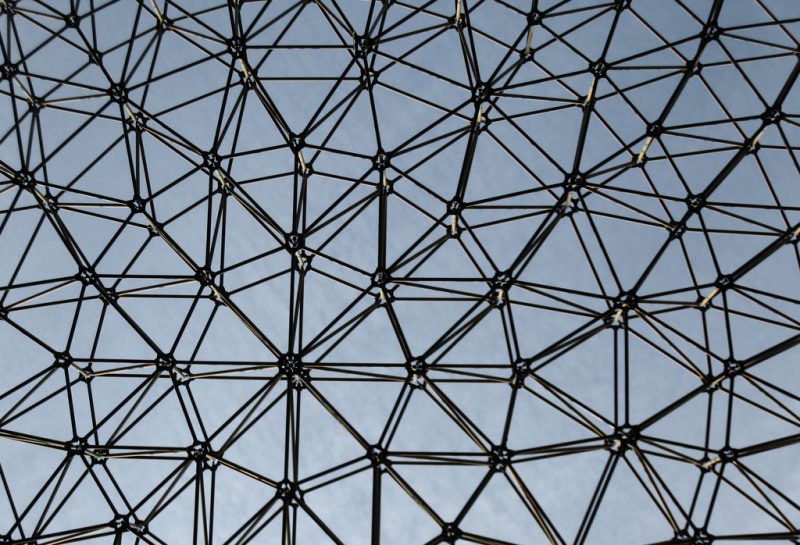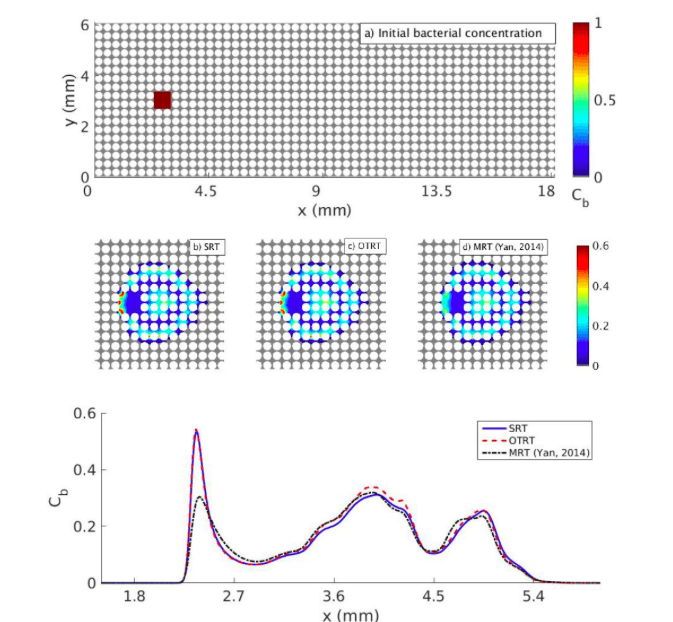
Important geochemical and biogeochemical processes such as organic carbon decomposition and contaminant remediation take place at the pore scale. Pore-scale modeling provides a powerful tool to uncover the dynamic and kinetic processes related to the subsurface reactions, because it allows to directly examine the reactions in complex geometries, and provides mechanistic insights into macroscopic field observations. The Lattice Boltzmann method (LBM) is one of the most widely used pore-scale methods and has been used to study various geophysical and biogeochemical processes in porous and fractured media.
The LBM can capture the physics of macroscopic behaviors, such as fluid flow and mass transport, through controlling the local mesoscopic operations of pseudo-particles that move on a regular lattice. Three types of LBMs, single-relaxation-time (SRT) LBM, two-relaxation-time (TRT) LBM, and multiple-relaxation-time (MRT) LBM, have been applied to various flow and transport in complex geometries. Among them, the TRT LBM employs two relaxation parameters to relax the particle distributions, having one fixed but the other tunable. It maintains the simplicity of the SRT method in terms of implementation while retaining the advantages of the MRT method in terms of numerical accuracy and stability. Until recently the TRT method has been utilized to address different flow, but its applications to transport have not yet been well documented.
This study applies the TRT LBM to various transport phenomena, including advective-diffusive-reactive transport in uniform flow, Taylor dispersion in a pipe, solute transport in a packed column, and bacterial chemotaxis in porous media. The results illustrate that the tunable relaxation parameter in the TRT LBM enables the TRT method to produce robust numerical performances in terms of accuracy and stability. The TRT LBM, in general, achieves a good balance between simplification of numerical implementation and stability of numerical computation.
Therefore, the TRT LBM can be applied to simulate a broader range of transport phenomena than the SRT LBM, such as transport with large advective velocity and/or small diffusion coefficient in complex geometries, demonstrating the significant potential of the TRT LBM in predicting various geophysical and biogeochemical processes in subsurface environments.
Fig. 1 shows the comparisons of bacterial concentration among the three LBMs: the TRT and SRT methods generate similar microbial distributions, which are generally higher than that in the MRT method around high values and lower around low values. The results illustrate that the TRT method produces the same precision with the SRT method and the better than the MRT. Furthermore, the SRT exhibited better numerical stability than the SRT (see the original paper for more results).

Initial distribution of bacterial concentration. b-d) Distributions of the simulated bacterial concentration obtained by SRT, optimal TRT (OTRT), and MRT around the injection cavity at t = 0.26 hours. e) Distributions of the simulated bacterial concentration along the centerline parallel to the direction of flow (y = 3 mm). The bacterial concentration, Cb, was normalized by the injecting bacterial concentration. Concentration distribution of solute in a slice of a 3D packed column 10.78 s after the solute injection. The concentration was normalized by the concentration of the injected solute. Republished with permission from Elsevier from https://doi.org/10.1016/j.advwatres.2017.09.003.
To summarize, this study extends the applications of the TRT LBM to transport phenomenon, especially in complex geometries. The TRT LBM provides a valuable means to examine the microscale processes of various biogeochemical reactions in the subsurface environment, such as contaminant transport and organic carbon decomposition. The microscale presentations could advance our understanding of macroscale observations.
These findings are described in the article entitled Two-relaxation-time lattice Boltzmann method and its application to advective-diffusive-reactive transport, recently published in the journal Advances in Water Resources. This work was conducted by Zhifeng Yan and Siliang Li from Tianjin University, Xiaofan Yang from Beijing Normal University, and Markus Hilpert from Columbia University.








